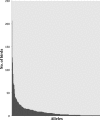Extraordinary MHC class II B diversity in a non-passerine, wild bird: the Eurasian Coot Fulica atra (Aves: Rallidae)
- PMID: 24683452
- PMCID: PMC3967895
- DOI: 10.1002/ece3.974
Extraordinary MHC class II B diversity in a non-passerine, wild bird: the Eurasian Coot Fulica atra (Aves: Rallidae)
Abstract
The major histocompatibility complex (MHC) hosts the most polymorphic genes ever described in vertebrates. The MHC triggers the adaptive branch of the immune response, and its extraordinary variability is considered an evolutionary consequence of pathogen pressure. The last few years have witnessed the characterization of the MHC multigene family in a large diversity of bird species, unraveling important differences in its polymorphism, complexity, and evolution. Here, we characterize the first MHC class II B sequences isolated from a Rallidae species, the Eurasian Coot Fulica atra. A next-generation sequencing approach revealed up to 265 alleles that translated into 251 different amino acid sequences (β chain, exon 2) in 902 individuals. Bayesian inference identified up to 19 codons within the presumptive peptide-binding region showing pervasive evidence of positive, diversifying selection. Our analyses also detected a significant excess of high-frequency segregating sites (average Tajima's D = 2.36, P < 0.05), indicative of balancing selection. We found one to six different alleles per individual, consistent with the occurrence of at least three MHC class II B gene duplicates. However, the genotypes comprised of three alleles were by far the most abundant in the population investigated (49.4%), followed by those with two (29.6%) and four (17.5%) alleles. We suggest that these proportions are in agreement with the segregation of MHC haplotypes differing in gene copy number. The most widespread segregating haplotypes, according to our findings, would contain one single gene or two genes. The MHC class II of the Eurasian Coot is a valuable system to investigate the evolutionary implications of gene copy variation and extensive variability, the greatest ever found, to the best of our knowledge, in a wild population of a non-passerine bird.
Keywords: Adaptive genetic variation; Immunogenetics; concerted evolution; gene copy variation; pathogen-mediated selection.
Figures




References
-
- Agudo R, Alcaide M, Rico C, Lemus JA, Blanco G, Hiraldo F. Major histocompatibility complex variation in insular populations of the Egyptian vulture: inferences about the roles of genetic drift and selection. Mol. Ecol. 2011;20:2329–2340. - PubMed
-
- Alcaide M, Edwards SV, Negro JJ. Characterization, polymorphism, and evolution of MHC Class II B Genes in Birds of Prey. J. Mol. Evol. 2007;65:541–554. - PubMed
-
- Alcaide M, Edwards SV, Negro JJ, Serrano D, Tella JL. Extensive polymorphism and geographical variation at a positively selected MHC class II B gene of the lesser kestrel Falco naumanni. Mol. Ecol. 2008;17:2652–2665. - PubMed
-
- Alcaide M, Rodríguez A, Negro JJ, Serrano D. Male transmission ratio distortion supports MHC-linked cryptic female choice in the lesser kestrel (Aves: Falconidae) Behav. Ecol. Sociobiol. 2012;66:1467–1474.
LinkOut - more resources
Full Text Sources
Other Literature Sources
Research Materials

